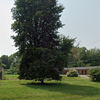Pulled from the auction block, Cobblestone Schoolhouse may be preserved by the town
GUILDERLAND — The Cobblestone Schoolhouse in Guilderland Center, built just before the Civil War, may yet be saved for public use.
The school district, which hasn’t taught students there since the 1940s, had entered into a contract with Auctions International for an auction that was supposed to start earlier this month.
“We paused on that … largely in response to an email that we received from Assemblymember Pat Fahy who represents the Guilderland school district, who voiced some interest in making sure that that property remains in the public domain,” Superintendent Marie Wiles told the school board at its Dec. 5 meeting.
Since then, Fahy has been working with the school district and with Guilderland Supervisor Peter Barber, Barber told The Enterprise this week.
Although over the last year town board members have not discussed the proposition at a public meeting, Barber said he has taken board members to the schoolhouse individually.
He said of Councilman-elect Gustavo Santos, “Everyone but Gus has been there. They love it.”
Barber said that, before he became a lawyer, he studied architecture and believes the schoolhouse is structurally sound.
“Our hope would be to help them,” he said of the school district, calling it “a bit ironic” that the town would take on the task of preserving school district history.
Barber said that the town has “a good track record” of saving Guilderland’s historic buildings. The town owns two 19th-Century homes of historic importance. (It also co-owned with the village of Altamont an historic home built by the village’s first doctor, which was demolished.)
The town-owned Mynderse-Frederick House, a center-hall Colonial on Schoharie Road, now Route 146 in Guilderland Center, was built in 1802 by Nicholas V. Mynderse. He ran a tavern there and was elected as Guilderland’s first supervisor. Three generations of the Frederick family then lived there including Stephen Frederick, also a Guilderland supervisor.
The town-owned Schoolcraft House, a Gothic Revival mansion, which was going to be demolished for a parking lot, was built in the 1840s on Guilderland’s Western Turnpike, now busy Route 20, as a summer retreat by Congressman John L. Schoolcraft, one of the original presidents of the Albany bank now known as KeyBank.
Barber also noted that the Cobblestone Schoolhouse property backs up to the town’s Keenholts Park.
He said that Guilderland Center residents with children now get in their cars to drive to the neighboring park. If the town acquires the land, Barber said, they could walk to the park on a trail that would become part of the town’ pedestrian network.
Shifting priorities
Nearly two years ago, after a quarter-century of debate and discussion, the school board unanimously passed a resolution stating that the schoolhouse property “is declared to be of no further use or value to the District and in fact, continued ownership of Property is fiscally detrimental to the District.” The resolution authorized listing the property for sale or auction.
Built in 1860, the one-room schoolhouse was used as a classroom until 1941. It stands on land deeded to the school district in the early part of the 19th Century by Stephen Van Rensselaer, the Dutch patroon, for the purpose of creating a schoolhouse.
It took the school district years to get a clear title to the property.
Soon after the board passed that resolution, on Feb. 15, 2022, Barber told the town board, after reading a story about it in The Enterprise, he had written to the school superintendent, saying “We might be interested.” Barber emphasized the word “might,” adding, “We’ve got to do a lot of due diligence. Quite honestly, we’ve got to find out what will we use the building for.”
Asked about the use again this week, Barber envisioned “recreating what the school looked like in 1941, a year before America entered World War II.”
He recalled the “little desks” that had been in the building when he toured the school as a young Guilderland student himself. He even recalled a globe at the schoolhouse from the 1930s that he said would be “a great educational tool.”
Barber said he had asked Wiles to see if the school district was storing the Cobblestone Schoolhouse furniture somewhere.
At the Dec. 5 school board meeting, the board’s president, Seema Rivera, said she had learned “through hearsay” that the town might be interested in obtaining the property.
“We’re obviously pushing off the auction,” she said. “And I don’t think we want to do that forever. So having them make this offer, I think in the next month would be reasonable.”
Rivera also mentioned money the district had put into the auction process.
In 2017, the school district’s superintendent of buildings and grounds had requested $30,000 to make needed repairs on the schoolhouse, at which several school board members balked. Coverage of this brought many members of the public, town officials, and Fahy to the board’s April 2017 meeting after which the board approved the repairs.
Floor joists and floorboards were replaced with fir appropriate to the age of the building and the roof soffit and fascias were replaced. The school had been reroofed in 2003 with era-appropriate cedar-shake shingles.
That same year, as Guilderland School Board members listed their priorities for the coming year, two of the nine members, who are no longer on the board — Catherine Barber, Peter Barber’s wife, and Allan Simpson — said that restoring the Cobblestone Schoolhouse was a priority.
Catherine Barber at the time described the schoolhouse, having peeked in through the window, as being frozen in time: There were the old-fashioned school desks and even maps on the wall as well as a pot-bellied stove, she said.
Board priorities have since shifted.
Wiles said at the Dec. 5 meeting of the 2017 request for a new schoolhouse floor, “I can remember sitting at this table, weighing, how do we afford that while we’re trying to decide how to provide for our students as well? …. Honestly, it is not the mission of the school district to do historic preservation. We are thinking about the future.”
According to the Albany County assessment rolls, the property, which is an acre, with the schoolhouse, has a full-market value of $196,941.
Barber told The Enterprise this week that no purchase price has been agreed on. His hope is that the school board will agree to give it to the town so that it can be preserved, and that he is working with Fahy to see about securing “funds for restoration.”
He notes that, although the schoolhouse looks to be structurally sound, it would need upgrades for public use. For example, the property has an outhouse but not an indoor bathroom, Barber said.
He also said it would have to be “ADA-compliant,” meaning it would have to follow requirements set out by the Americans with Disabilities Act and be accessible to people with handicaps.
No timeline or agreement for transfer has been made. First, Barber said, “we make sure the school board is on board,” then the town board would have to formally accept it.
History
In 1982, the Cobblestone Schoolhouse was placed on the National Register of Historic Places along with a slew of other buildings in town — including the Helderberg Dutch Reformed Church, which has since burned, and the Mynderse-Frederick House, both also on Guilderland Center’s Main Street, as well as Rose Hill, the Hamilton Union Presbyterian Church, and the John Schoolcraft House, all on Route 20 in Guilderland.
The National Archives Catalog says that the schoolhouse “is one of only several cobblestone buildings in the county” and was “carefully maintained by the Guilderland School District since its construction in 1860.” The catalog goes on to describe the traditional 19th-Century construction technique as “exceptionally well executed.”
The catalog notes the building’s “smooth ashlar quoins,” the “stone lintels and sills,” and the “open bell tower … with curvilinear hipped roof.” In addition to picturing the schoolhouse, the catalog also pictures the privy in back, a structure that still stands. The schoolhouse still has no indoor plumbing.
The Cobblestone Museum says of the schoolhouse, “Its solid foundations and walls remind one of a Revolutionary blockhouse.” The museum also notes that an inscription, carved on one of the upper front quoins, says, “R.E. Zeh, mason, 1860.”
That was first noted in a 1961 Altamont Enterprise column by Guilderland town historian Arthur B. Gregg, who wrote of the few rare cobblestone structures in town. Gregg wrote that cobblestone construction took place just from the 1820s until the Civil War era. Rochester is the center of the cobblestone region with few far-flung cobblestone buildings elsewhere.
Building with cobblestones was a laborious process, Gregg wrote, and it typically took to or three years to build a cobblestone house.
Guilderland Center’s Cobblestone Schoolhouse was used as headquarters for the now-defunct Guilderland League of Arts and had been the site of sporadic school field trips over the years.
Blaise Salerno, who had been superintendent of the Guilderland schools from 1993 to 2000, had, during his tenure, started a committee to look into possible uses of Cobblestone Schoolhouse and grants to restore it. He had thought it could be used as a meeting center and also be “recreated, so students could come in and see what schools were like, back in the day.”
People in town had volunteered to donate old books and other objects they had saved to help transform the schoolhouse into what it was like when it was used, he said.
“One thing that’s really sad about our focus on the future is that we forget about our past,” Salerno said. “I really think that that building, and the whole concept of Guilderland Center — back then it was … a thriving little community — to me that has real value, to be preserved.”



